Sometimes you combine what you have to do with what you want to do. Donna has an appointment at SEF to begin the residency process, so we have to go to the city of Santarém. I am in the middle of reading José Saramago's book Journey to Portugal, and as I previously reported, I am marking and saving some of the locations in my Maps app so that we might research and visit them. Thus today's mission is twofold: take care of some necessary personal business that might let us stay in Portugal, and test out a method that might make the staying worthwhile. At the core of both tasks is the hope of being more, or at least a little bit, Portuguese.
Saramago's book is nearly one thousand (digital) pages, and I am just past six hundred. Santarém is included in the chapter called 'The Oldest House', around page five-ninety, so it is top of mind. Saramago begins with:
"Santarém is a strange city. Whether its inhabitants are out in the streets or in their houses, it always seems closed. There does not seem to be any link between the old town and the new neighborhoods: each of them is in its own place, turning its back on the other. Once again, the traveller admits this is his personal view, but the facts – or rather the lack of them – confirm that it's true: nothing can happen in Santarém. It's like another Sleeping Beauty castle, without the sleeping beauty."
De Lisboa (Gare do Oriente) para Santarém
Our journey begins in Lisbon's Oriente station, with a short train ride north along the Rio Tejo. It is a ride into the past, going from Calatrava's geometry to the old-time Portugal of tile panels and whitewash. The neighborhood around the station, Santarém's Ribeira, is run down, and in large part, abandoned. The fog is thick.
Ao Centro Histórico
It's a misty, steep walk from the train station to the historic town center. There are small, but questionable signs of life: large orange trees, a herd of muddy geese, lots of dog feces (I hope it's dog feces). The limestone-cobbled walks near the station fade to sand, then we climb the stairs to the Igreja de Santa Cruz. Standing high in the Ribeira, the landscaping around it is badly neglected, and – as Saramago presaged – the church is closed. We stop to admire: it is pretty, in a basic way, and the stone around the entrance is kept clean. But, the plants sprouting from the bell tower give me some concern.
We become disoriented among the narrow streets and abandoned stone walls, where a single parked car makes passage nearly impossible. The street becomes more narrow and more steep again, and right before it must shrink into another set of stairs, it opens onto another road. We cross that road, and join a curving stone path (calçada) that takes us upward. Suddenly we are in a small plaza, with a tall stone scepter at one end. Behind the "obelisco", up another set of steps, and we arrive at a landing, which the locals deem large enough to act as the service entry to some military building. A mini-truck backs me into a corner, and I have to wait as a soldier instructs the driver. Out of the small car park, and there is a raised courtyard with quite a few people of various ages and ethnicities. We have found the SEF office.
Now we know where it is, so we feel free to spend the morning exploring. The fog is starting to thin. Just down the end of the block is the Torre das Cabaças. The lower level seems to be in a ruined state, the roof is gone but there are people inside. They are cleaning the small entryway, but alas, it is closed on Tuesdays. Across from the tower is a small Gothic church, the Igreja de São João do Alporão (I think that's a rhymer; lots of tildes). Inauspiciously, it is closed, too.
Igreja de Santa Maria da Graça
With the first churches closed, I am uncertain what to expect at the next. We head deeper into the old town, and quickly arrive at the Igreja de Santa Maria da Graça. Its doors are wide open, a welcoming, cascading portal topped with a rich and prodigious "rosácea". Inside, it is newly restored, extra-clean, and surprisingly tall. The entry is down a full flight of stairs, so the ceiling beams are that much farther. With the renovation, we can more clearly read that the Gothic seems to be married with touches of "manuelino", though something is lost without the patina. Donna's name emerges everywhere in the chapels, which seems a curious omen given part of the day's mission – her family’s past plays a part. As we approach the portal to depart, we are caught off-guard by the two-finger salute from the graffiti framed against the wall opposite: the sacred and the profane. And we head back out into it.
Igreja da Misericórdia
Back into the twisty-tight streets, where we stop and watch several drivers make three point turns at every intersection. There is no room to make it in one go, or pass by while the drivers turn – and it is done slowly. But a short walk brings us to the Igreja da Misericórdia. A pair of parked work vans pinch us in at the entry gate. With inventive classical lines and forms, this may contrast our experience in Graça.
Inside, the architectural language appears to be Tuscan, but not with a spare or heavy expression – these columns are lithe, and tattooed with scrolls and flowers. Near the bases, the surface pattern is faded, but above, near the capitals, the gold is still iridescent. The ribbed vaults look as if they've been inflated, parachute-like. Wound around the foot of the column on the left is a curling "escada", leading to a charming covered pulpit.
The altar is on a raised level, another flight up, also in inverse to Graça. In a side room, the church-folk here keep a small museum, with several statues, a spare crucifix, and some handsome liturgical hardware. On the other side of the altar is the sacristy, where they display vivid, layered vestments in an equally vibrant space. This church gives a light and cheerful spirit, underscored by the enthusiastic attendant.
Igreja de Santa Maria de Marvila
We pass by it a few times as we circle in the old town, but the Marvila church stays closed. While we walk, we discover several 'crumb-lines' of stickers on the paving stones, brightly colored paw prints. They don't seem to lead anywhere in particular. Yellow, red, and orange, they are cleverly sized for the sidewalk stones. Perhaps it's some artistic prank or guerrilla marketing ploy, but enough of them are missing that we cannot discern a purpose.
At the recommendation of the attendant in the Igreja da Misericódia, we stop for lunch at TasCÁ. It's Portuguese comfort food. As always, I try to avoid turning this into a food blog, but I really enjoy our time here. They elevate the idea of 'pork and beans' to something truly memorable: a covered tureen of stewed and tender pork meat, on the bone and with the fat cap, along with three kinds of smokey sausages, flavorful beans, carrots, and cabbage. They serve the accompanying rice in a mini-paella pan. I also ask for a basket of fries because, with the pricing, I just don't expect to be presented with a hearty meal fit for two – but the fries are addictive, so I don't mind. With fado gently playing, it's a moving Portuguese moment.
Igreja de Santa Maria das Alcáçovas e Jardim das Portas do Sol
After lunch, Donna attends her appointment. I am free to explore, so I head for the "miradouro" in the garden (Portas do Sol) at the end of the street. I follow the street past the Torre das Cabaças, past a burned out theater, and then along a lovely tree-lined avenue, with several bright and tidy houses. But, I find the small church of Alcáçovas closed. Luckily it is right at the entrance to the park.
The grounds are wide, flat, and sandy, but are edged with stone battlements and raised lookouts. On my left, a tortured tree on a steel rack, strait-jacketed by a tiled bench catches my attention. I imagine: the local preservation society, charged with saving this knotty, twisty tree, tries to support it by installing the metal frame, then tries to disguise the steel 'trunk' with the tile bench. There's an explanation there, possibly, but it is a surreal sight.
So I head to that side of the park, the north side; below is the Ribeira and the train station. The views out are breathtaking. The moon is out early, driving away the haze, and it floats above the Rio Tejo in a crystal cyan sky. On the opposite bank to the west is the small village of Tapada. A strait red bridge connects it and then the city of Almeirim beyond. At the far end of the garden are the actual "portas", which is now a kind of amphitheater. To the south, the view is of the village of Alfange, and the distinctive domed "campanário" of the Igreja São João Evangelista. The park is even wide enough to provide a look back to the west, toward Santarém, and the back-side of the church of Graça.
Igreja de São Nicolau
I return to SEF to check on Donna, but she is still waiting. She is holding number seventy four. When I left for the Jardim, they passed through the fifties. They remain in the sixties, so I head out again. The next church on my list is the Igreja de São Nicolau. The exterior suggests a hybrid of the other churches: a classical pediment at the entry, a petite 'pope' statue set in a recess, a "janela rosa", an application of cake-frosting banding and swirls above the windows, with lots of fanciful shapes on the top edge. The columns don't support anything, so it doesn't read like architecture; it's 'trim'.
The interior is also a fusion: the roof shape and supports reminiscent of Graça, columns like those from Misericórdia (with fainter tattoos), Manueline touches in the chapels, and lots of wonderful azulejos sprinkled throughout. Though I'm not sure it all goes together, it's not unpleasant and it does seem to be written in Portuguese. I am all alone, in utter silence, as the sunlight from the oculus centers on the red velvet chair in the altar. It takes serious will power to keep from sitting, just to see what might happen. If churches are where salvation is sought, I may be missing my chance.
Igreja de São Francisco
Donna is still not done with her appointment, so I try to squeeze one more church into the day. I cross out of the old town, down a shallow valley, and up another stairway (Escadinhas das Figueiras). On the rise is the Igreja de São Francisco. But the big doors are shut, so I content myself by taking pictures of the facade and some of the stone details. Just as I am about to leave, a man pops out of the door to the left, and energetically invites me inside.
He explains the basic layout of things, hustles me to the side door to the church, and leaves me to explore. The church is an enormous, hollow ruin – and it is captivating. It has Gothic, Manueline, and classical elements, but all sharing the same decayed state. The elements play together amazingly well. The space is being used for events, and there is a bare stage at the crossing, with lots of loose electrical gear scattered about. There is a scrim at the open end of the nave where the altar should be, but now there is just a substantial, sleepy, back-lit face. It reminds me of the Cathedral of Christ the Light in Oakland.
Road noises and pigeons easily make their way in. The floors and roof are skinned with beige-grey material. I assume this covering protects something underneath or above, but it might also hide some cheap temporary construction. A pair of carved wooden figures stand watch at the front of the stage. They both look anxious, and are dusted with feathers and droppings from their flock. The area above the crossing is still unprotected, and sunlight is streaming in at the edges of the roof tiles.
There are so many instances of pointed Gothic arches, overlaid with Manueline stonework, then crossed with fluted classical pilasters, and dressed with Portuguese tile panels. The parts are left to be fused by time and form the hybrid that was proposed in the Igreja de São Nicolau. Thin washes of light weave into the mix from the windows and cracks, including a bold splash from the large rose window above the portico. The rose is enigmatically echoed, at times, in my camera lens.
This creates highlights, various linear shapes and edges, intimate hollows where beams are rebuffed and contrasting shadows arise. The surfaces provide diversity as well, as there are variations with illumination and age, in the tones and textures all around. The harder stones hold their polish and mirror a cool light, whilst the softer blocks transmit warmth. Where the pigments and ornaments are worn away, other colors and patterns are exposed.
Claustros do Convento de São Francisco
Stepping out of the church, I am joined by Donna. She begins her inspection inside, while I circle the cloisters. Behind the running arches and buttresses, there are places where the masonry has given way. Stones stand in a rough stockpile in the unnaturally verdant courtyard; other carved stone pieces are sown across the carpet.
The stone-cold convent and church seem fragile to the point of softness; you want to give it a hug. Having been neglected, the parts wait here for a time when they are cherished again. Regarding that time, Saramago remarks:
"In the opinion of the traveller – and when he has an opinion, he says so – this ruin should only be restored sufficiently to ensure it is conserved. It is and should stay a ruin. Ruins are always more eloquent than any restored building. On the day this church opens its new doors to the public, as they say, it will lose its greatest strength: that of bearing witness. No-one will stop to wonder beneath its portal, unless in a casual way, if it was here that King John II was crowned. The present has more than enough places in which to speak to the future. This is the voice of the past. Better to be silent in this cloister, at the edge of this empty tomb, stumbling on the dust of centuries: silence is as vital as speech."
Our penultimate stop before catching the bus home is the Praça de Sá da Bandeira. A band of skateboarders reign within the square, and we have to to pause and dodge in order to avoid collisions and interrupted photographs. Opposite the enormous Igreja do Seminario, the tea-pot-like Igreja de Nossa Senhora da Piedade promises a more intimate encounter. But the decorations are intense and, for me, rather harsh. Plus the constant flow of locals, stopping in to pray, makes it difficult to be comfortable playing the tourist.
It is late now, and the big church is closed, which is a fifty-fifty proposition in any case, if our current tour is any guide. It is odd to see the big church standing so close to, and uphill from, the little one. So the visit may be ending on notes of awkward intimidation – from children and gods.
Just a bit more time, so we double-back to Nicolau, which Donna did not see. I have time to sit in the pew, consider the day, and wind down. The caretaker is the only other person now in the building; he lays out the cloths and candles, and prepares the church for service. Donna finishes her appraisal, and we turn to the bus schedule. We still need to find the bus terminal and Google and Siri aren't helping – "autocarro", "estação", 'bus station' – nothing works.
We exit to the "largo" that fronts the church, and notice a young woman working in a gift shop. We find several paw print stickers on her door step; the name of the shop is "Aqui Há Gato". The mystery of the stickers is solved! Generously, the shopkeeper gives us directions to the station, even placing a dropped-pin in my Maps app. Another mystery solved, and we all share a good laugh.
The bus route takes us out through the mid-rises and store fronts of the newer parts of town. Perhaps it feels more generic and less 'old Portugal' than the churches and gardens, but this is Portugal, too. If we are beta-testing today, immigration processes and tour planning, then this day's effort yields a positive result. But there is more testing ahead.
The people of Santarém are uniformly hospitable and engaging. The city has a long history, and they allow it to be old, to collect dust and remembrance. As Saramago advises, they must find and balance their city at the threshold between ruin and restoration. Our commission is somewhere within the memories and expectations of this place, so that we can call this country 'home'. We just need to keep searching.






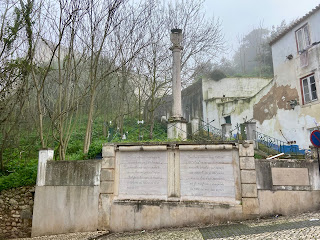







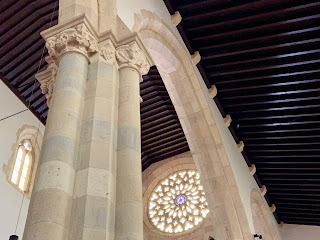




















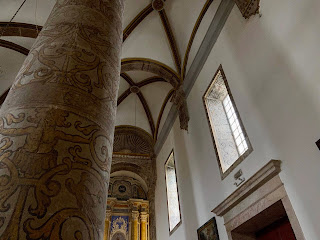












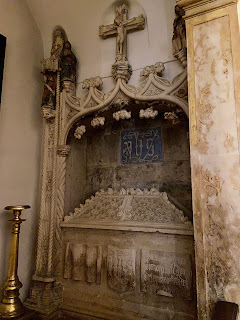























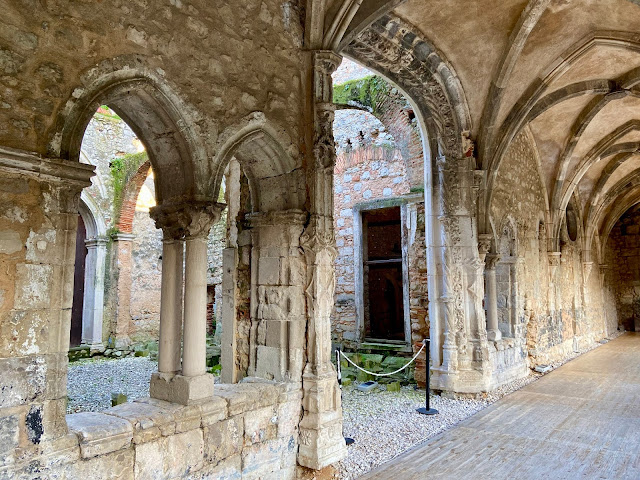








No comments:
Post a Comment